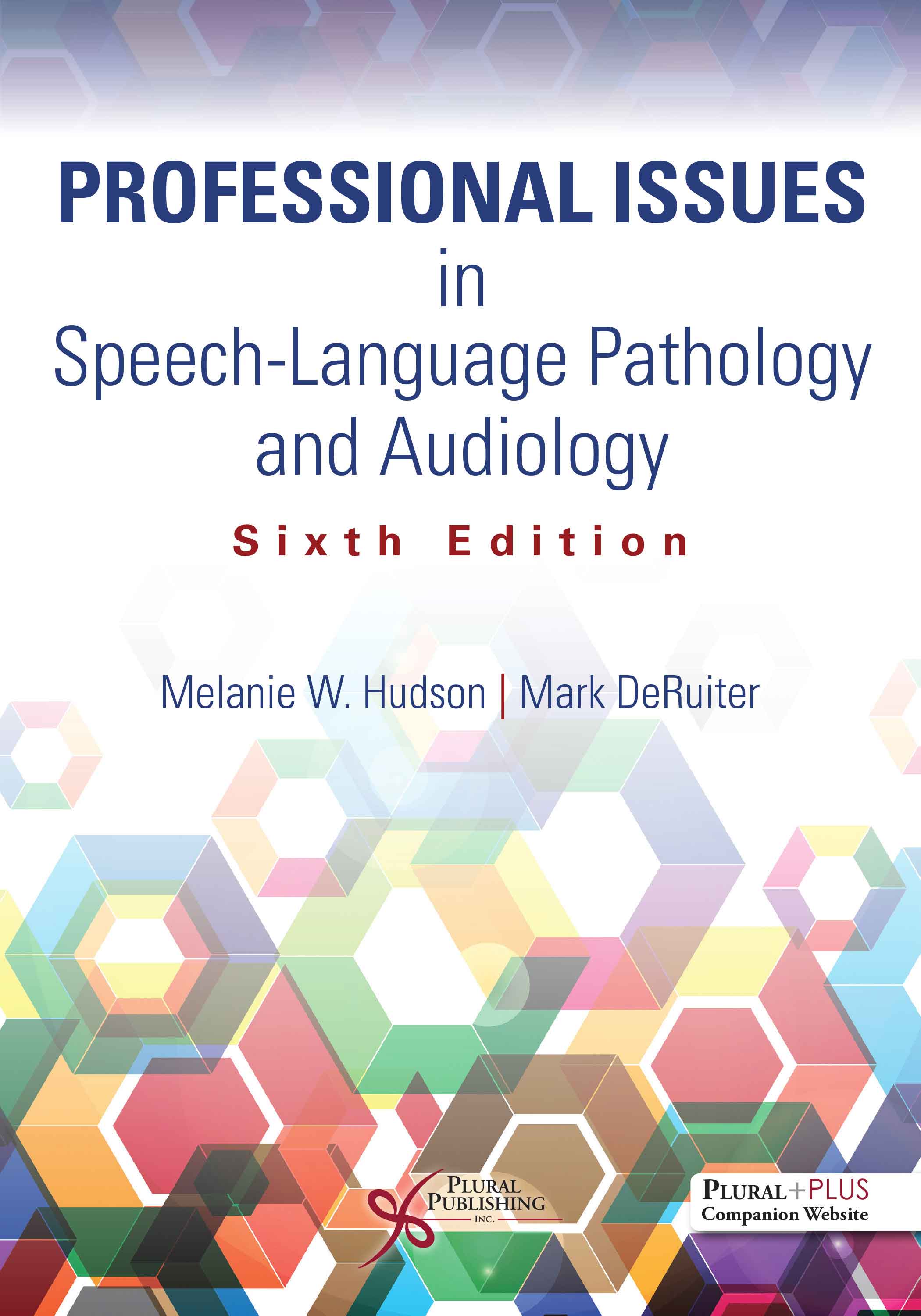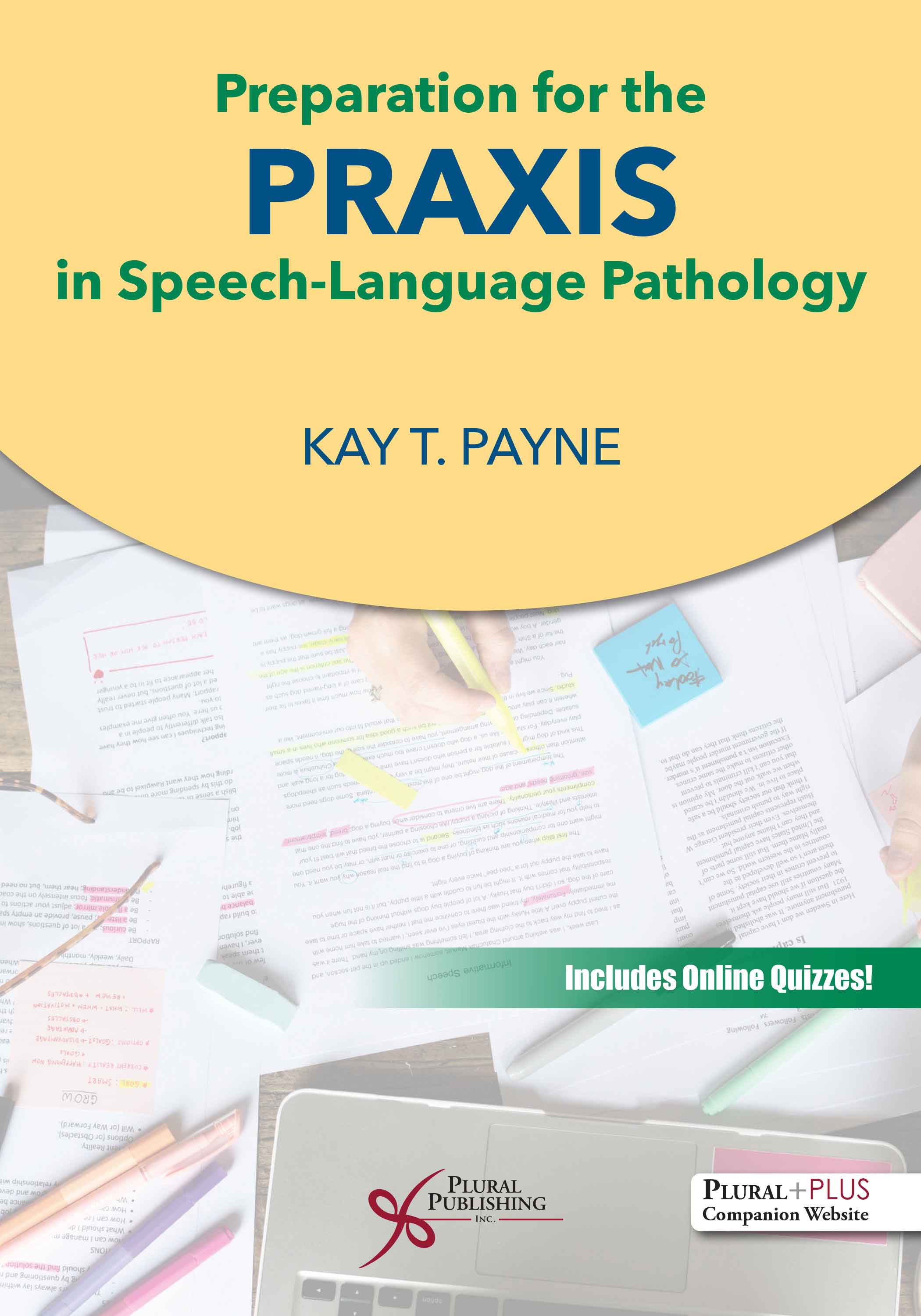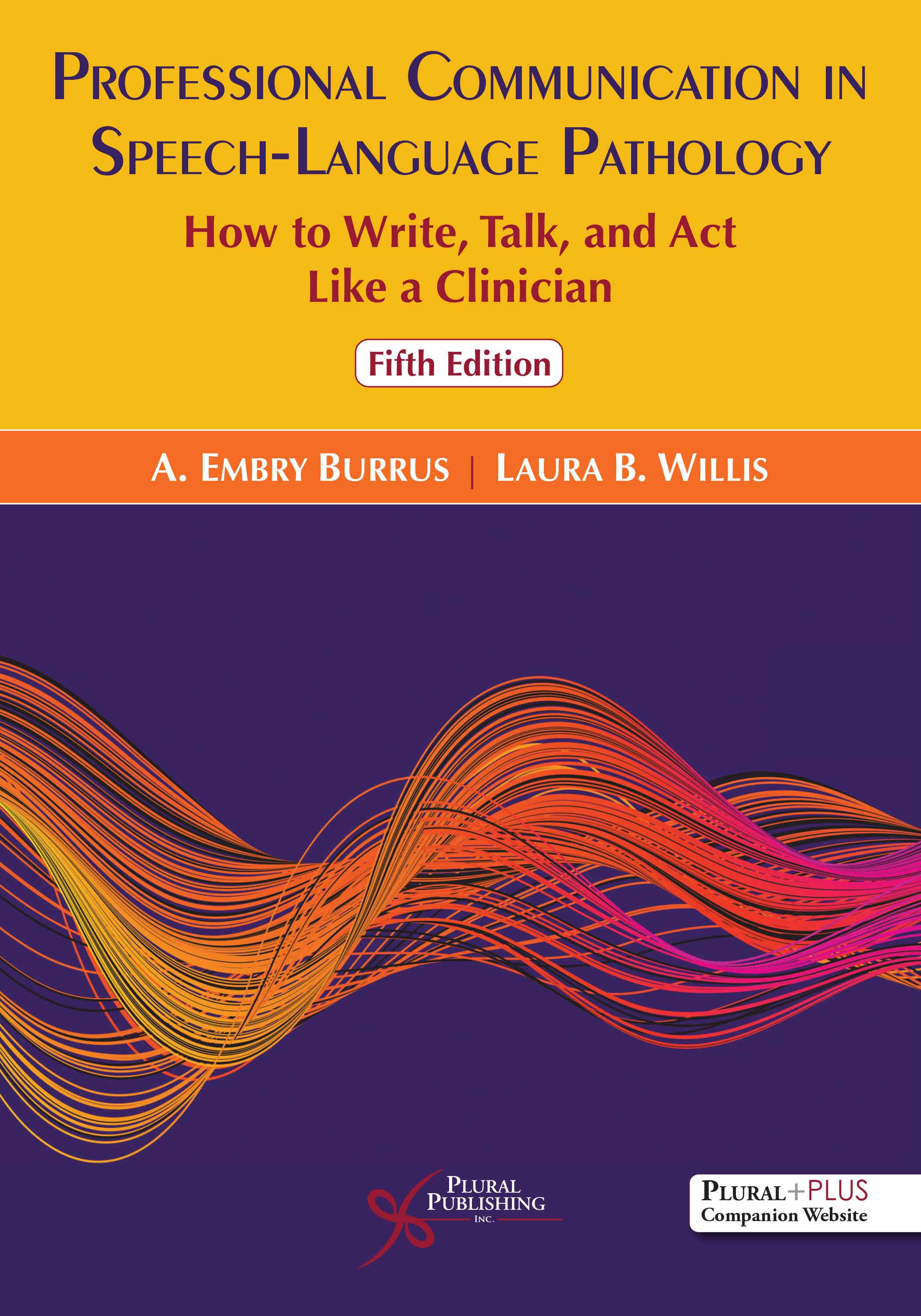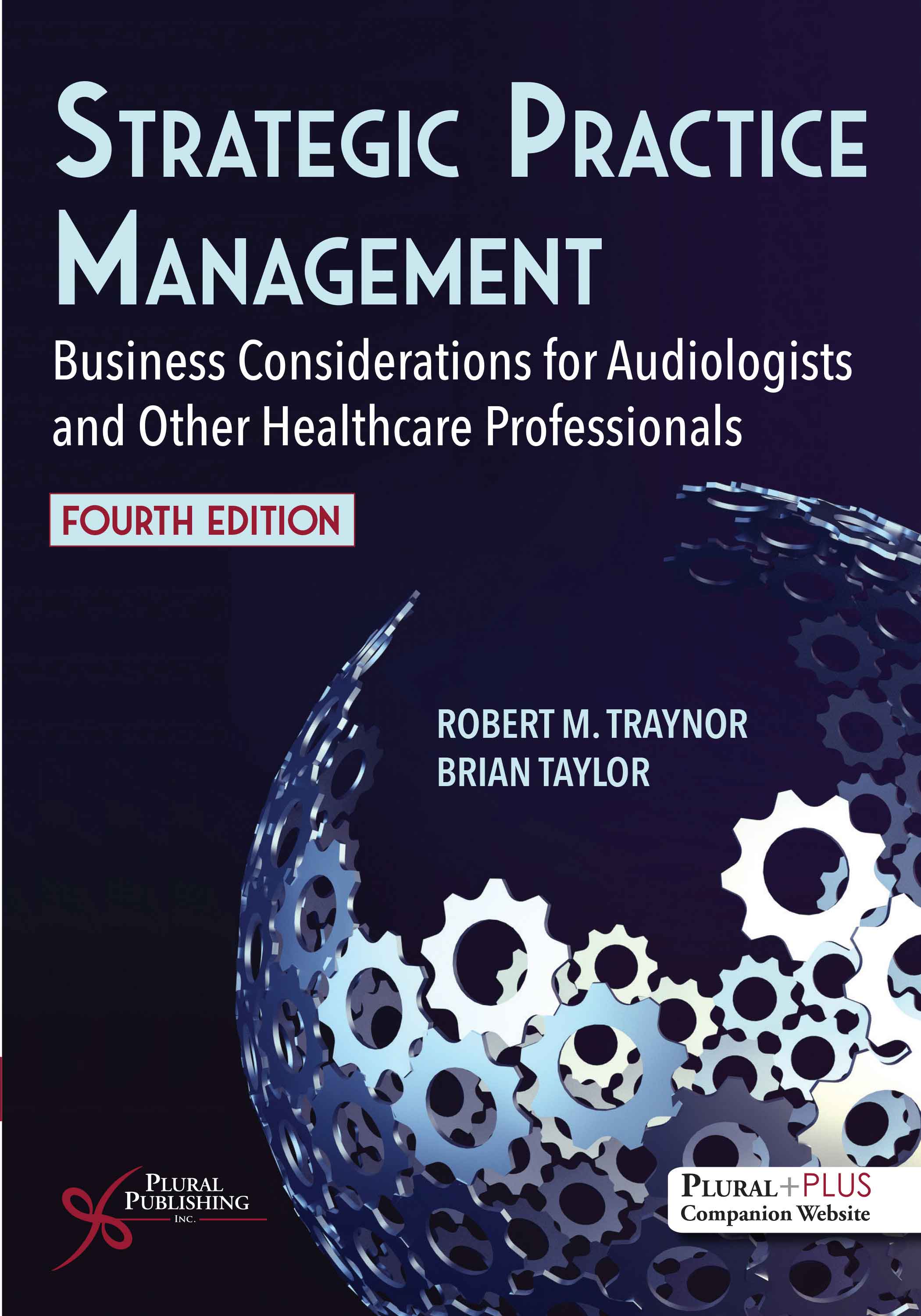
Professional Issues in Speech-Language Pathology and Audiology
Sixth Edition
Melanie W. Hudson, Mark DeRuiter
Details: 541 pages, Two-Color, Softcover, 7" x 10"
ISBN13: 978-1-63550-655-6
© 2025 | Available
For Instructors
Purchase
This sixth edition of Professional Issues in Speech-Language Pathology and Audiology is intended to be a primary text for students in speech-language pathology and audiology, as well as a resource for practitioners, providing a comprehensive introduction to contemporary issues that affect these professions and service delivery across settings. It aims to provide a better understanding that day-to-day clinical work, as well as personal professional growth and development are influenced by political, social, educational, health care, and economic concerns. By instilling a big-picture view of the profession, future clinicians will be more prepared to make informed decisions as they provide services, engage in advocacy efforts, and plan their careers as audiologists or speech-language pathologists.
The book is divided into four major sections: Overview of the Professions, Employment Issues, Setting-Specific Issues, and Working Productively. The information presented in each section provides the reader with a better understanding and a new perspective on how professional issues have been affected by both internal and external influences in recent years including technological advances, demographic shifts, globalization, and economic factors. Chapter authors are recognized subject-matter experts, providing a blend of both foundational and cutting-edge information in areas such as evidence-based practice, ethics, job searching and employment issues, interprofessional practice, service delivery in health care and education, technology, cultural competence, supervision, and leadership.
Students reading this book will appreciate how the professions have evolved over time while acquiring a sense of where they are right now as they prepare to enter the professional world. Each of the topics covered in the book will continue to play important roles in the future of speech-language pathology and audiology, providing early career professionals with the requisite knowledge to achieve success in any setting.
New to the Sixth Edition
- New information on issues related to the COVID-19 pandemic
- Coverage of recent changes in technology
- Updates to ASHA certification requirements, the Assistants certification program, and the 2023 ASHA Code of Ethics
- New contributors: Nicole E. Corbin, Sandra Liang Gillam, Erin E.G. Lundblom, Christine T. Matthews, Shari Robertson, Rachel A. Ritter, and Jennifer P. Taylor
- Updated list of acronyms used in the book
Key Features
- Chapters authored by recognized experts in communication sciences and disorders
- Each chapter begins with an introduction and ends with a summary of key areas
- Critical Thinking questions for each chapter accessible online
- Case studies related to child and elder abuse
- Case studies related to advocacy
PluralPlus Online Ancillary Materials
For Instructors: PowerPoint slides
For Students: Critical Thinking questions for each chapter
From the Foreword:
“The editors have been immersed for many years in undergraduate and graduate education as well as in the practice of audiology and speech-language pathology. Their varied experiences are illustrated in their selection of topics and authors. …Chapters on competency-based education and practice, leadership, and stress and conflict in the workplace offer valuable guidance for students as they prepare to shift to the next phase of their evolving careers. Ultimately, this is a resource for crafting a pathway to a vocation. The final chapter, Advocacy, by Dr. Tommie Robinson, serves as a coda to the abundance of resources contained in this text. He offers the “why” for what we do in the professions. According to Dr. Robinson, we all have the opportunity to promote our excellence, help those we serve to speak for themselves, and create access for others who need our services. The authors in this text craft the framework for this endeavor.”
—Barbara H. Jacobson, PhD, CCC-SLP
Foreword
Preface
About the Editors
Contributors
Acronyms
Section I. Overview of the Professions
Chapter 1. Professions for the Twenty-First Century
Melanie W. Hudson and Mark DeRuiter
Introduction
Trends in Technology and the Digital Revolution
Twenty-First Century Trends and Issues
Evidence-Based Practice
Summary
References
Chapter 2. Professional Issues and Organizations: From the Past to the Present
Jaynee Handelsman
Introduction
Practical Dilemmas and Affiliation
Organization of the Professions
Common Characteristics of Professional Associations
Historical Perspective on Scope and Practice Framework
Common Characteristics of Professional Associations
Related Professional Associations
State Associations and Impacts on Licensure
Student Organizations
International Professional Associations
Focus on Recent History
Summary of the Evolution of the Professions
Summary
References
Chapter 3. Establishing our Competencies in Professionals: Education, Certification, and Licensure
Lissa Power-deFur
Introduction
How Do You Know You Are Competent?
Credentialing Programs
State Licensure
Professional Development and Certification Maintenance
Demonstrating Expertise in a Particular Area of Practice
Credentialing Graduate Programs
Next Steps: After Graduation
Summary
References
Chapter 4. Professional Ethics, Accountability, and Liability
Jaynee A. Handelsman
Introduction
Standards of Professional Conduct
Conflicts of Interest
Role of Professional Associations
Ethical Issues in Practice Management
Ethical Issues in Supervision
Ethical Issues in Academia
Ethical Dilemmas
Unethical Complaint Process
Recent Changes and Future Directions
Summary of Professional Ethics
Introduction to Professional Accountability
Accountable Care
Managing Risks and Risk Intelligence for Accountable Clinicians and Organizations
Current Critical Risks Facing Health Care
Concept of Risk Intelligence
Raising the Bar on Accountability - The Value Equation
Learning Health Systems - An Opportunity to Shape the Future of Accountability
Professional Accountability Requires Relentless Reimagining
Conclusion and Summary of Professional Accountability
Introduction to Professional Liability
Summary
References
Chapter 5. International Alliances
Robert M. Augustine, Tina K. Veale, and Kelly M. Holland
Introduction
Definitions: Alliances, Partnerships, and Collaborations
International Alliances, Partnerships, and Collaborations Promoting Cultural Responsiveness for a Global Workforce Grounded in Standards of Practice
International Alliances and Access
International Alliances Through Other Professional Organizations
International Alliances and Attributes of High-Quality Programs Offered Through Colleges and Universities
Alliances Promoting “Macro” International Experiences
International Alliances Promoting Global Research for Scholars
Final Summary and Perspectives
Summary
References
Appendix 5–A. Definitions of Eight Transferrable Competencies Valued in the Workforce
Appendix 5–B. Global Learning Value Rubric Glossary
Appendix 5–C. Proposed Competencies for Global Engagement
Appendix 5–D. An MOU Checklist for International Collaborations
Chapter 6. Applying Evidence to Clinical Practice
Lizbeth H. Finestack and Stacy K. Betz
Introduction
Evidence-Based Practice
Evaluating Assessment Evidence
Using Assessment Evidence
Evaluating Intervention Evidence
The Future of Evidence-Based Practice
Summary
References
Section II. Employment Issues
Chapter 7. Workforce Issues and Finding Employment
Mark DeRuiter and Cathy DeRuiter
Introduction
The Current Workforce
ASHA Membership and Affiliation Data
Shortage of PhD Students and Faculty in CSD
The Future: Factors Affecting Employment
Job Search
Consider what Information is Available about You
Resumé
Completing Your Application
Interviewing Success
The Anatomy of an Interview
“Forbidden” Interview Questions
Postinterview Follow-Up
Considering the Benefits That Might Be Available to You
Salary and Benefits
Retirement and Other Incentives
Receiving the Offer
Making the Decision
Is This Where I Want to Work?
Red Flags
Getting Started
Summary
References
Resources
Appendix 7–A. Sample Resumé
Chapter 8. Building Your Career
Shari Robertson and Marva Mount
Introduction
Getting Off to a Good Start
Professional Ethics
Creating A Career Path
Your First Mentor
Professional Skills That Foster Success
Imposter Syndrome
Professional Engagement and Responsibilities
Career Considerations
Summary
References
Chapter 9. Assistants in Audiology and Speech-Language Pathology
Diane Paul, Tricia Ashby-Scabis, and Lemmietta G. McNeilly
Introduction
Rationale for Use of Assistants
Challenges of Using Assistants
Chronology of Ethical and Professional Practice
State Regulations
Supervisory Requirements
Assistant Employment Trends
Training for Assistants
Credentialing Assistants
Supervision of Assistants
Supervision of Assistants in Speech-Language Pathology
Job Responsibilities of Audiology Assistants
Job Responsibilities of Assistants in Speech-Language Pathology
Payment of Services Provided by Assistants
Research Related to Assistants
Future Research Issues
Summary
References
Appendix 9–A. Assistants in Audiology and Speech-Language Pathology: Key Word Definitions
Section III. Setting-Specific Issues
Chapter 10. Health Care Legislation, Regulation, and Financing
Jeffrey P. Regan
Introduction
Medicare
Medicaid
Private Health Insurance
Coding Systems
Key Health Care Legislative and Regulatory Issues
Summary
References
Chapter 11. Service Delivery in Health Care Settings
Jeffrey P. Johnson, Christine T. Matthews, and Alex Johnson
Scope of Chapter
Health Care Settings and Key Responsibilities
Routine Considerations for Speech-Language Pathologists and Audiologists in Health Care
Dynamic Considerations for Speech-Language Pathologists and Audiologists in Health Care
Summary
References
Chapter 12. Knowledge and Skills for Providing Evidence-Based Services in School-Based Settings
Sandra Laing Gillam
Introduction
Population in U.S. Schools
Federal Legislation, Landmark Court Cases, and the Provision of Special Education Services in Schools
Due Process
Identification, Assessment and Intervention in Schools
Service Delivery Options
Scheduling in the Schools
Working with Support Personnel
Professional Practice in the Schools
Outreach
Supervision
Research
Administration and Leadership
Summary
References
Chapter 13. Service Delivery Issues in Early Intervention
Corey Herd Cassidy
Introduction
What Is Early Intervention?
Roles and Responsibilities of Speech-Language Pathologists and Audiologists in Early Intervention
Guiding Principles of Early Intervention
Services Based on the Highest Quality of Evidence
Other Considerations for Early Intervention Services in Natural Environments
Challenges and Evidence-Based Practices for Remote Service Delivery
Summary
References
Chapter 14. Service Delivery Issues in Private Practice
Robin L. Edge
Introduction
Advantages and Disadvantages of a Private Practice
Private Practice Options
Business Plan
Marketing Strategy
Location of Private Practice
Private Practice Credentials and Qualifications
Ethics
Cultural Competence
Resources Needed for Private Practice
Payment for Services
Rates for Services
Billing
Outcomes Data for Private Practices
Networking
Summary
References
Resources
Section IV. Working Productively
Chapter 15. Strategically Promoting Access to Speech-Language Pathology and Audiology Services
Brooke Hallowell
Introduction
Identifying Barriers to Access
Ensuring Others Understand the Need for Our Services
Optimizing Reimbursement for Clinical Services
Advancing Legislation to Improve Access
Advocating for Our Professions
Actions for Advocacy and Professional Assertiveness
Care Extenders
Expanding Access through Technology
Educating the Public
Adjusting Service-Providing Environments
Summary
Acknowledgments
References
Chapter 16. Documentation Issues
Nicole Corbin and Erin E. G. Lundblom
Introduction
Purposes of Clinical Documentation for Consumers
General Principles of Clinical Documentation for Pracititioners
Types of Clinical Documentation
Influences on Clinical Documentation
Summary
References
Chapter 17. Developing Leadership Skills
Gail J. Richard
Introduction
Roles of a Leader
Effective Leadership Skills
Fiduciary Responsibilities
Strategies for Conflict in Leadership
Pathways to Leadership
Summary
References
Chapter 18. Safety in the Workplace
Cynthia McCormick Richburg and Donna Fisher Smiley
Introduction
Regulatory Agencies
Accrediting Agencies
Policies, Procedures, and Trainings
Personal and Environmental Hazards
Infection Control in Clinical and Educational Settings
Confidentiality of Client and Research Participant Information
Summary
References
Appendix 18-A. Acronyms
Chapter 19. Overview of Interprofessional Practice and Interprofessional Education
Alex Johnson
Introduction
Interprofessional Practice
Interprofessional Education
National and International Organizations and Resources for IPE and IPCP
Summary
References
Chapter 20. Child Abuse and Elder Mistreatment
Carolyn Wiles Higdon
Introduction
Child Abuse and Neglect
Elder Mistreatment and Neglect
Palliative Care and Hospice
Summary
References
Resources
Other Websites
Videos Related to Palliative Care and Hospice
Appendix 20–A. Case 1: Joshua
Appendix 20–B. Case 2: Sam
Appendix 20–C. Case 3: Miriam
Appendix 20–D. Common Reactions in the Grief Process
Chapter 21. Working With Culturally and Linguistically Diverse Populations
Shirley Huang and Pui Fong Kan
Introduction
Demographic Landscape in the United States
Speech, Language, and Hearing Clinicians and Scientists: Demographic Profiles
Defining Cultural and Linguistic Diversity
“An Inconvenient Truth”
Cultural Competence, Responsiveness, and Humility
Service Delivery for Children and Adults
Systems-Level Inequities
Action Is Long Overdue: Moving the Field Forward
Summary
References
Chapter 22. Supervision and Mentoring
Melanie W. Hudson and Mary Sue Fino-Szumski
Introduction
A Brief History of Supervision and Mentoring
The Supervisory Process
Key Elements of the Supervisory Process
CORE Model of Supervision and Mentoring
Supervisory Style and Communication Skills
Transition: Supervisor to Mentor/Preceptor
Regulations, Standards, and Guidelines
Clinical Fellowship Experience and Audiology Externship
Speech-Language Pathology Clinical Fellowship (SLPCF)
Supervision Postcertification
Supervision of Students and Support Personnel
Ethical Issues
Cultural, Linguistic, and Generational Issues
Supervision of Challenging Supervisees
Technology and Supervision
Training in Supervision
Supervisor Accountability
Future Needs in Supervision and Mentoring
Summary
References
Resources
Chapter 23. Technology for Service Delivery, Professional Practice, and Student Training
Carol C. Dudding and Rachel A. Ritter
Scope of Chapter
The Digital Revolution
Technology for Service Delivery
Professional Practice Settings
Education and Training
Ethical Considerations
Summary
References
Chapter 24. Managing Stress and Conflict in the Workplace
Mark DeRuiter and Jennifer P. Taylor
Introduction
What Is Stress?
Burnout and Compassion Fatigue
What Are the Risks for Experiencing Burnout?
Workplace Conflict
Workplace Violence
Coping With Stress: The Importance of Self-Care
Talking With Others
Employee Assistance Programs
Mindfulness Practices for Stress Reduction
Summary
References
Resources
Chapter 25. Advocacy
Tommie L. Robinson, Jr.
Introduction
Definitions
Recognizing the Benefits of Being an Advocate
Advocacy Case Examples
Developing a Game Plan for Advocacy
Resources
Summary
References
Index
Professional Issues in Speech-Language Pathology and Audiology, Sixth Edition comes with access to supplementary student and instructor resources on a PluralPlus companion website.
The companion website is located at: https://www.pluralpublishing.com/publication/pislpa6e
STUDENTS:
The student resources include Critical Thinking Questions.
To access the resources, you must register on the companion website and log in using the access code located in the front of your textbook. If you purchased an eBook directly from Plural accessible on the Plural eReader, the resources are accessible within the Plural eBook.
INSTRUCTORS:
The instructor resources include PowerPoint Lecture Slides. You will also have access to the student resources listed above.
To access the resources, you must contact Plural Publishing, Inc. to be verified as an instructor and receive your access code.
Email: instructormaterials@pluralpublishing.com
Tel: 866-758-7251 (toll free) or 858-492-1555

Preparation for the Praxis in Speech-Language Pathology
First Edition
Kay T. Payne
Details: 221 pages, B&W, Softcover, 7" x 10"
ISBN13: 978-1-63550-314-2
© 2020 | Available

Interprofessional Education Toolkit: Practical Strategies for Program Design, Implementation, and Assessment
First Edition
Nassrine Noureddine, Darla K. Hagge, William Ofstad
Details: 269 pages, B&W, Softcover, 8.5" x 11"
ISBN13: 978-1-63550-217-6
© 2022 | Available

Clinical Methods and Practicum in Speech-Language Pathology
Seventh Edition
M.N. Hegde
Details: 413 pages, B&W, Softcover, 6" x 9"
ISBN13: 978-1-63550-691-4
© 2025 | Available

Professional Communication in Speech-Language Pathology: How to Write, Talk, and Act Like a Clinician
Fifth Edition
A. Embry Burrus, Laura B. Willis
Details: 280 pages, B&W, Softcover, 7" x 10"
ISBN13: 978-1-63550-658-7
© 2026 | Available

Strategic Practice Management: Business Considerations for Audiologists and Other Healthcare Professionals
Fourth Edition
Robert M. Traynor, Brian Taylor
Details: 983 pages, B&W, Hardcover, 7" x 10"
ISBN13: 978-1-63550-766-9
© 2026 | Available


